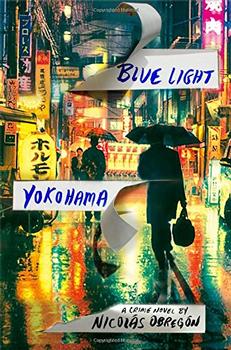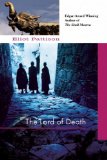Summary | Excerpt | Reviews | Beyond the book | Read-Alikes | Genres & Themes | Author Bio

Crime novels are a dime a dozen, but The Shadow Walker by Michael Walters
stands apart for both its exotic setting in modern-day Mongolia and its
intriguing investigator Nergui. Offering a fast-paced and dark setting, Walters,
a management consultant, presents an exciting debut novel.
Throughout the book the author provides detailed descriptions of Mongolia, the
resulting portrait is of an unsettled country, formerly occupied by the Soviet
government and now feeling the effects of western modernization, all the while
maintaining its nomadic history. Here, for example, is British police officer
Drew McLeish's first glimpse of Ulan Baatar's city center:
The road widened into a brightly lit avenue, lined with a mix of official-looking buildings, many studded with communist emblems, and newer commercial offices, some with Korean, Japanese or even American business names .... This could be any Eastern European city struggling to come to grips with life after the Soviet Union—the first shoots of Western capitalism alongside drab weathered concrete, poorly maintained roads and streetlights, shabby squares and inner-city parks. Familiar logos, neon-lit on the summits of office buildings, competed with stylized images of soldiers and stars—the fading murals of communism.
Adding to the exotic flavor of Ulan Baatar are the settlements of the
traditional round nomadic tents, gers, found on the outskirts of the
city, adjacent to the bland apartment complexes originating from the Communist
era. The author also draws attention to the culture clash of Mongolian clothing,
ranging from cheaply made, mass-produced Chinese suits to traditional dels,
heavy robes with ornate belts, worn by both steppe herdsmen as well as older
urban residents.
Nergui, former head of the Serious Crimes Team who rose through the police ranks
during Communist oppression, represents as much of a mélange of cultures as does
Ulan Baatar. As Drew studies Nergui's physical appearance, he notes his
distinctive Mongolian features with dark and almost leathery skin, "…as though
it had been burnished by the sun and wind of the desert," as well as his
high-quality suit contrasting with his garish shirt and tie. Having studied in
both London and Boston, Nergui has adopted certain Western characteristics, but
Drew recognizes Mongolia's past in him, too, sensing "it would not be
difficult…to imagine him, centuries before, riding out as a member of Genghis
Khan's armies, leading the conquest of the known world." With his questionable
former ties to the Communist government, as well as his experience in the West,
Nergui, like his country, remains mysterious.
A few times clues emerge a tad bit too conveniently. In a mining site shanty
town Nergui and his protégé Doripalam seemingly stumble upon a former
revolutionary, who provides plenty of useful information. Later, as Nergui
wonders how Doripalam unearths a slew of impressive connections, the latter
vaguely replies, "Did a bit of searching on the internet—got some basic
information. Also got some data from government systems."
Overall, however, the book successfully combines an unusual locale with plenty
of thrills, and readers will eagerly look forward to reading the next two books
in the series - Adversary and The Outcast (both published in the
UK in 2008, USA publication date unknown).
Gers or Yurts
The Mongolian ger (known more commonly as a yurt in the West) has been used
as a home by steppe nomads for more than 2500 years and is still a common home
even in urban areas.
Since nomads relocate many times over a year, it is essential that their
dwellings be easily assembled and dismantled. A ger can be erected within a few
hours on top of a wooden floor. While in the summer this floor remains slightly
off of the ground to avoid moisture, in the winter it is constructed directly
onto the soil in order to prevent drafts. The structure's support frame is made
of wood with lattices forming a circular wall, with a post-and-lintel doorway
always pointing toward the south. Willow rods attach to the framework and join
at a wooden hoop to form the roof. The cover consists primarily of wool felt
swathed with white cotton. Once inside, a basic stove heats a ger during cold
weather. A family can load their dismantled ger and belongings rapidly onto a
truck or a camel train. Usually one truck or six camels can haul a family's ger
and possessions.
Architecturally fascinating, a ger's vast roof span is achievable without the
need for the usual internal supports such as posts, trusses, or beams. This is
due to the arrangement of the roof's central compression ring and a tension band
where the roof attaches to the wall. The strong roofline is able to withstand
earthquakes, wind, and snow.
A ger is a Mongolian herder's most valuable possession, and when a couple
gets married, its family will either construct or purchase a ger as their new
home. Each family has its own ger.
Several websites show fascinating pictures of gers and yurts, including
mongolyurt.com,
bluepeak.net,
and safecom.org.au.
Yurts are gaining in popularity outside of Mongolia. Starting at around USA $5000 for a 16 ft diameter model, yurts can be used in non-traditional ways for park camping, back-country skiing, studios, bed-and-breakfasts, and resorts.
![]() This review
first ran in the November 12, 2008
issue of BookBrowse Recommends.
This review
first ran in the November 12, 2008
issue of BookBrowse Recommends.

If you liked The Shadow Walker, try these:

by Nicolas Obregon
Published 2017
Haunted by his own past, his inability to sleep, and a song, 'Blue Light Yokohama,' Iwata is at the center of a compelling, brilliantly moody, layered novel sure to be one of the most talked about debuts in 2017.

by Eliot Pattison
Published 2010
A government bus filled with imprisoned illegal monks has overturned. Two women in an approaching sedan have been killed. Now Shan, an exiled Chinese national and a former Beijing investigator, must find the murderer.
Your guide toexceptional books
BookBrowse seeks out and recommends the best in contemporary fiction and nonfiction—books that not only engage and entertain but also deepen our understanding of ourselves and the world around us.